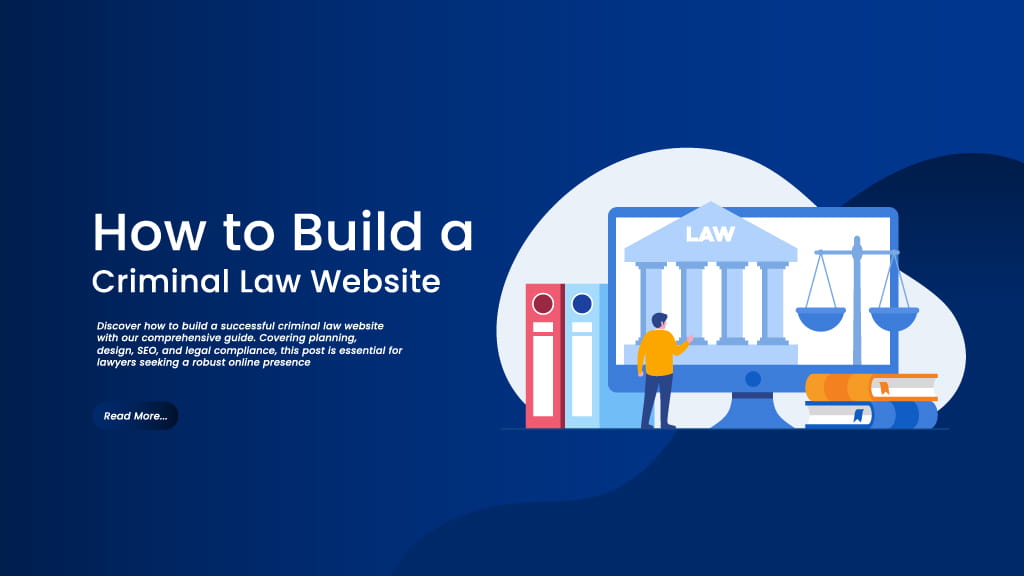In today’s digital era, a website is more than just an online business card for criminal law professionals. It is a powerful tool to establish credibility, attract clients, and share valuable legal insights. This guide explores how to build a criminal law website that enhances your professional presence and instills trust in potential clients.
What is a Criminal Law Website?
A criminal law website is where lawyers share their skills, services, and past successes. It should clearly explain your practice areas, how you defend clients, and what legal services you offer to help potential clients understand how you can assist them.
Why is a Criminal Law Website Essential?
A strong online presence is crucial in the competitive legal industry. Your website often gives potential clients the first impression of your practice. It should convey professionalism, authority, and your unique legal expertise. By creating a well-structured criminal law website, you showcase your qualifications and build confidence among visitors seeking legal assistance.
Key Components of a Successful Criminal Law Website
To ensure your website effectively represents your criminal law practice, include the following elements:
Professional Design: A clean, structured website layout exudes trust and credibility.
Quality Content: Including detailed descriptions of your services, biographies, and case studies.
Client Testimonials & Case Results: Build trust through real success stories and social proof.
Easy Contact & Consultation Booking: Simple ways for clients to reach out and schedule consultations.
Legal Blog & Industry Insights: A space for sharing case studies, legal updates, and expert opinions on criminal law matters.
These are the key elements of an excellent criminal law website. It provides valuable information and helps build trust with potential clients.
Plan Your Website for Maximum Impact
A well-planned website aligns with your business objectives, enhances user experience, and improves engagement through data-driven insights. Start by defining your goals. Are you looking to attract new clients, establish authority in criminal law, or provide educational resources? Your goals shape the structure and content of your site.
Set Goals for Your Criminal Law Website
Begin by defining what you want to achieve with your website. Goals may include:
Attract New Clients: Highlight your expertise to appeal to potential clients.
Establish Authority: Position yourself as a thought leader in criminal law.
Provide Resources: Offer valuable information and insights into criminal law matters.
Enhance Online Presence: Improve your visibility and accessibility online.
Understand Your Target Audience
Your website should cater to different visitors, including potential clients seeking legal representation, fellow lawyers for referrals, and law students looking for insights. You can tailor your content to provide relevant and useful information by understanding their needs.
Potential Clients: Focusing on how you can assist them with their legal issues.
Other Lawyers: Demonstrating your expertise for referrals or collaborations.
Law Students: Offering educational content and career insights.
Choose the Right Website Platform
Selecting the right platform ensures ease of management, scalability, and seamless integration with legal CRM tools and analytics. WordPress, for instance, is a popular choice due to its user-friendly interface, customization options, and SEO-friendly features. Whatever platform you choose, ensure it effectively supports your content and branding needs.
Ease of Use: Platforms like WordPress are user-friendly and widely used.
Customization Options: Ensuring the platform allows for the customization needed for a law website.
SEO Friendliness: A platform that supports SEO optimization is essential.
By carefully planning your criminal law website, you set a solid foundation for its success. This planning phase is critical in ensuring your website looks professional and effectively communicates your expertise and services to your intended audience.
Design Your Law Firm Website

A professional and well-structured design builds trust and reinforces your authority in criminal law.
Professional and Trustworthy Design
Your website’s design should reflect the seriousness and professionalism inherent in criminal law. Consider these elements:
Color Scheme & Branding: Use authoritative colors like navy blue, deep green, or muted gold.
User-Friendly Layout & Navigation: Ensure the layout is clean, organized, and easy to navigate. A structured and intuitive design makes browsing easy for visitors.
Readable & Professional Typography: Clean, professional fonts improve readability and enhance credibility. Choose fonts that are professional and easy to read, avoiding overly decorative styles.
Best Design Practices for Law Websites
Consistency: Maintain a consistent theme throughout your site to build brand identity.
Imagery: Use high-quality images that reflect your practice, such as images of your office or team.
Responsiveness: Ensure your site is mobile-responsive, as many users access websites on their phones.
Brand Identity Integration
Your website should reflect your law firm’s brand identity. Display your logo prominently, maintain a clear and consistent brand message, and use a tone that aligns with your firm’s image. High-quality visuals and a professional layout will further reinforce credibility and trust.
SEO Optimization for a Criminal Law Website
Search Engine Optimization (SEO) is critical for ensuring your criminal law website is visible and ranks well on search engine results pages. Proper SEO practices increase your site’s visibility and attract more targeted traffic, which can lead to increased client inquiries and conversions.
Incorporate Keywords Naturally
Primary and Secondary Keywords: Integrate your main keyword, “how to build a criminal law website,” and related terms throughout your site’s content, including headings, meta descriptions, and body text.
Keyword Placement: Strategically place keywords in the first and last paragraphs, headings, and subheadings for optimal SEO impact.
On-Page SEO
Title Tags: Ensure each page has a unique and descriptive title tag, including your main keyword.
Meta Descriptions: Write compelling meta descriptions (155-160 characters) that include your primary keyword and summarize the page’s content.
Image Optimization: Use descriptive alt text for images, incorporating relevant keywords where appropriate.
Off-Page SEO
Backlinks: Acquire quality backlinks from reputable law-related websites to enhance your site’s authority.
Local SEO: Optimize for local search terms if you target clients in specific geographic areas.
Content and SEO
Regular Updates: Keep your site’s content fresh and updated, as search engines favor regularly updated websites.
Quality Content: Prioritize creating high-quality, informative content over simply stuffing your site with keywords.
Technical SEO
Mobile Responsiveness: Ensure your site is mobile-friendly, as many users access websites through mobile devices.
Page Speed: Optimize your website’s load speed, as slow-loading sites negatively impact user experience and search rankings.
Effective SEO optimization is a game-changer for your criminal law website. It helps you reach your target audience more effectively and positions your website as a valuable resource in the criminal law field.
Mobile Optimization and Accessibility
In today’s digital landscape, ensuring your criminal law website is mobile-optimized and accessible to all users is not just a bonus; it’s a necessity. With significant internet traffic climaxing from mobile devices, your website must provide an optimal user experience across all platforms.
The Importance of Mobile-Friendly Design
User Experience: A mobile-optimized website offers a better viewing experience, making it easier for users to navigate and find information.
SEO Impact: Search engines like Google prioritize mobile-friendly websites in their rankings.
Broader Reach: A mobile-responsive design ensures that your website is accessible to a larger audience, regardless of their device.
Key Elements of Mobile Optimization
Responsive Design: Ensure your website automatically adjusts to fit any device’s screen size.
Touch-Friendly Navigation: Buttons and links should be easy to tap on a touchscreen.
Optimized Images and Videos: Ensure media files load quickly and display correctly on mobile devices.
Ensure Website Accessibility
ADA Compliance: Your website should meet the Americans with Disabilities Act (ADA) standards and be accessible to users with disabilities.
Readable Fonts: Use fonts that are easy to read on small screens.
Contrast and Color: Ensure sufficient contrast between text and background colors for readability.
Accessibility Features to Consider
Screen Reader Compatibility: Ensure your website is navigable and readable by screen readers.
Keyboard Navigation: Allow users to navigate your site using a keyboard, which is essential for those who cannot use a mouse.
Alt Text for Images: Provide descriptive alt text for images, aiding visually impaired users.
Mobile optimization and accessibility are not just about reaching a wider audience; they’re about inclusivity and providing a seamless experience for all users. Focusing on these aspects ensures that your criminal law website is effective, respectful, and accommodating to all visitors.
Monitor and Update Your Website
Regularly monitoring and updating your criminal law website is crucial for maintaining its effectiveness and relevance. This involves analyzing performance metrics, staying updated with legal trends, and ensuring the website reflects the latest in your practice and the field of criminal law.
Website Analytics
Analytics highlight how visitors interact with your content and reveal the effectiveness of your design, speed, and conversion strategies. Understanding why your website performs is crucial to improving it.
Traffic Analysis: Use tools like Google Analytics to monitor website traffic, user behavior, and engagement patterns.
Performance Metrics: Track key performance indicators, such as page load times, bounce, and conversion rates, to understand user experience.
Feedback: Consider user feedback and comments for insights into how your website is being received.
Importance of Regular Updates
Regular updates and security measures protect your site and clients’ sensitive information.
Content Freshness: Regularly update your blog and core content to keep the information current and relevant.
SEO Impact: Search engines favor websites with fresh, updated content, impacting your search rankings positively.
Legal Updates: Ensure all legal information and resources on your site are up-to-date with current laws and practices.
Maintain Website Security
A well-secured website builds trust with your visitors, safeguards your operations, and ensures compliance with legal standards. Below are two critical areas to focus on to keep your WordPress site safe and resilient.
Regular Backups: Implement strong security measures to protect your content from data loss, malware, hacking attempts, and cyber threats. Regularly back up your website to prevent data loss due to technical issues.
Security Updates: Implement SSL encryption, secure login protocols, two-factor authentication, firewall protection, and regular updates to prevent security vulnerabilities.
Respond to Technological Advancements
Your website must adapt to new technologies, user behaviors, and platform standards to remain competitive and relevant. Here is how you do it:
Adopt New Features: Stay updated on new web tools and features to improve your website’s performance and user experience.
Mobile Trends: Continuously optimize for mobile device trends to ensure a seamless user experience on all platforms.
Monitor Performance: Use analytics tools to track user engagement, monitor bounce rates, analyze page performance, and optimize site effectiveness with actionable insights.
Conclusion
Building and maintaining a criminal law website is a multifaceted endeavor that requires careful planning, practical design, content strategy, SEO optimization, and ongoing maintenance. This comprehensive guide has outlined the essential steps and considerations for creating a website that showcases your expertise in criminal law and connects meaningfully with your audience.
A well-executed website is the key to growing your legal practice and building trust with potential clients online. If you want to make your website even better, check out SupreoX. Our team of experts can help you improve user experience, strengthen security, and increase visibility for your criminal law website to the next level.
Frequently Asked Questions (FAQs)
How much does it cost to build a criminal law website?
Costs vary based on design complexity and features. Basic sites can be affordable, while advanced functionalities may increase the price.
How long does it take to create a criminal law website?
Depending on the complexity, it can take a few weeks to a few months from planning to launch.
Do I need technical skills to manage my website?
Many platforms are user-friendly, but basic technical knowledge helps. Alternatively, you can hire a professional for maintenance.
What content should I include on my criminal law website?
Include your services, attorney profiles, client testimonials, contact information, and a blog with legal insights.
How can I improve my website’s visibility on search engines?
Use relevant keywords, regularly update content, and ensure your site is mobile-friendly and fast-loading.











